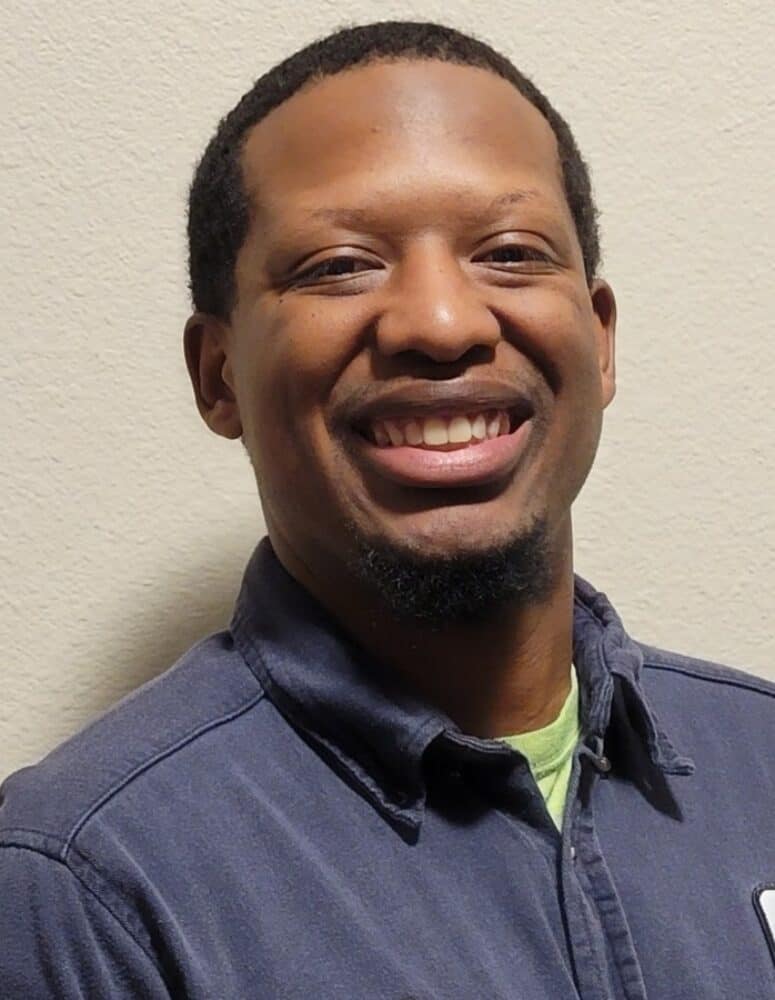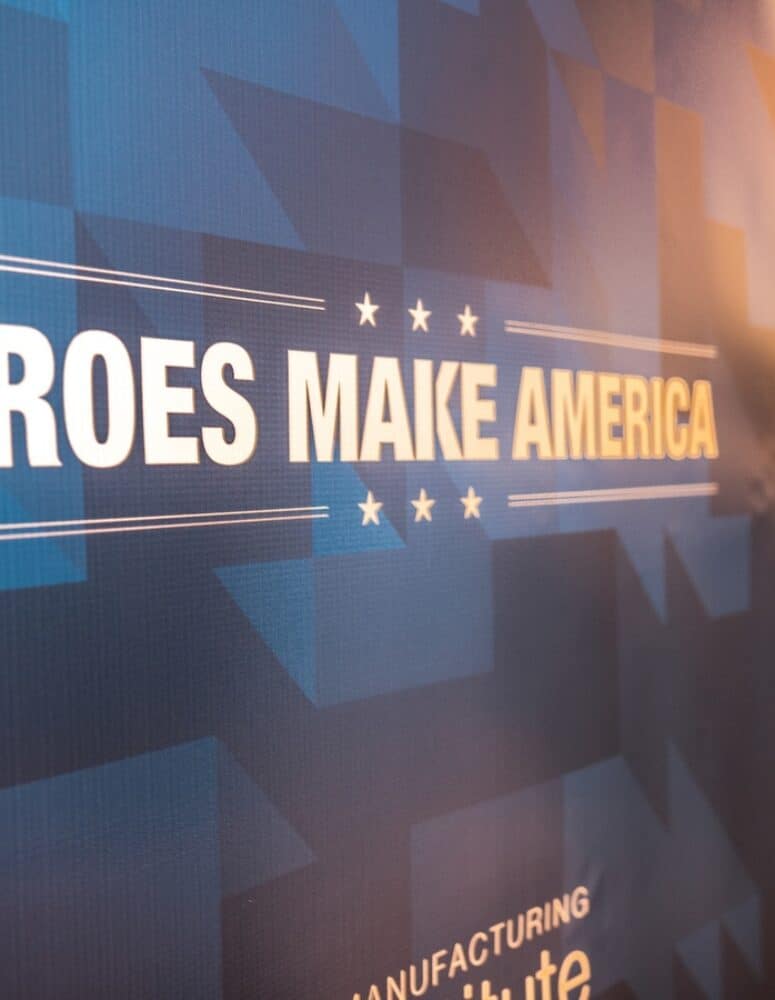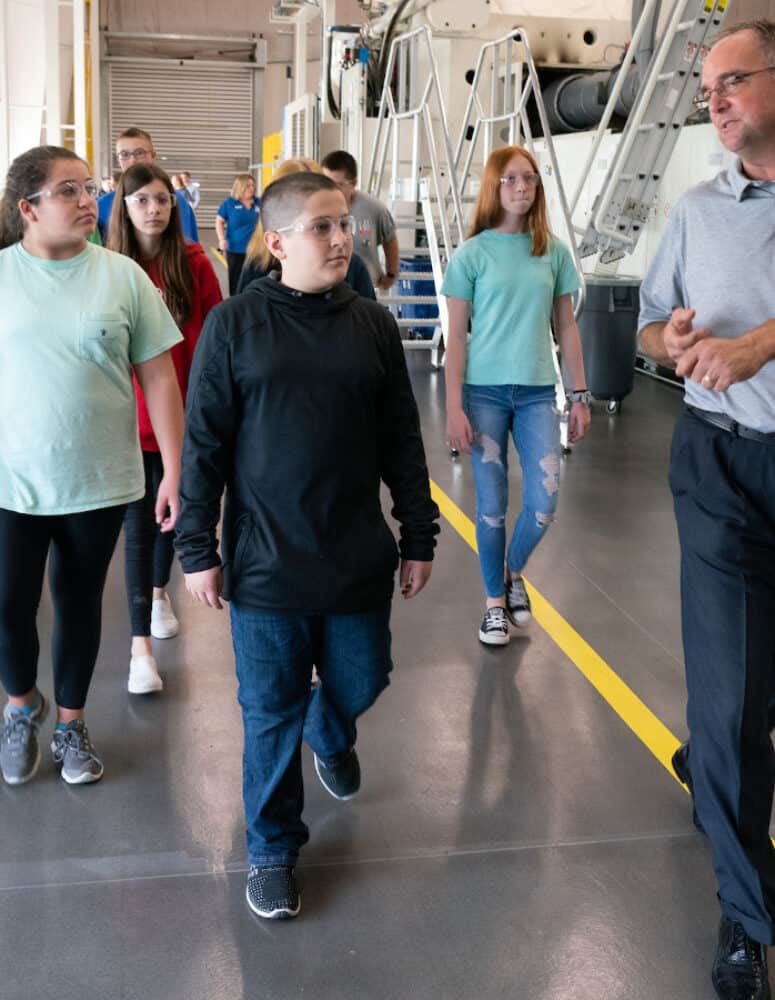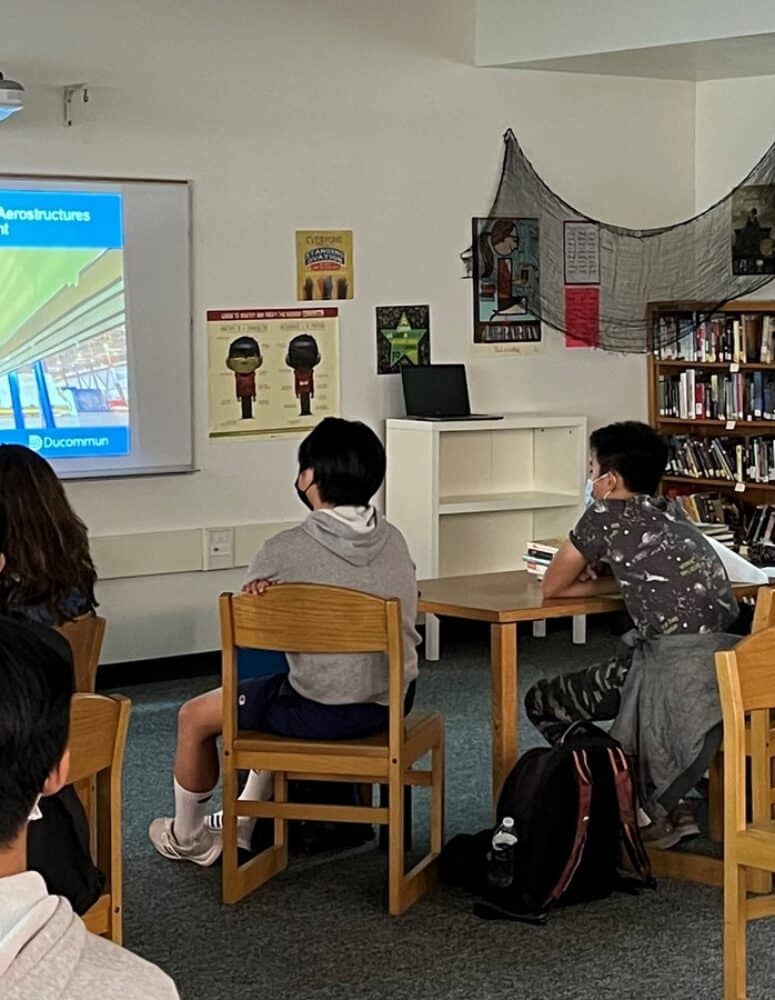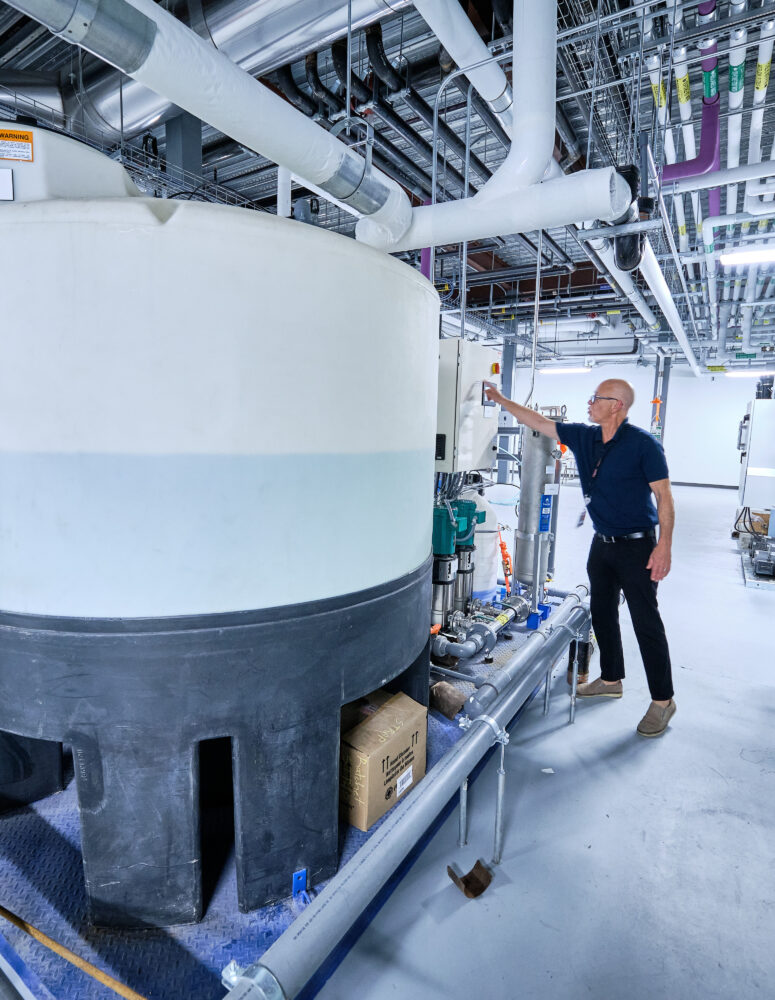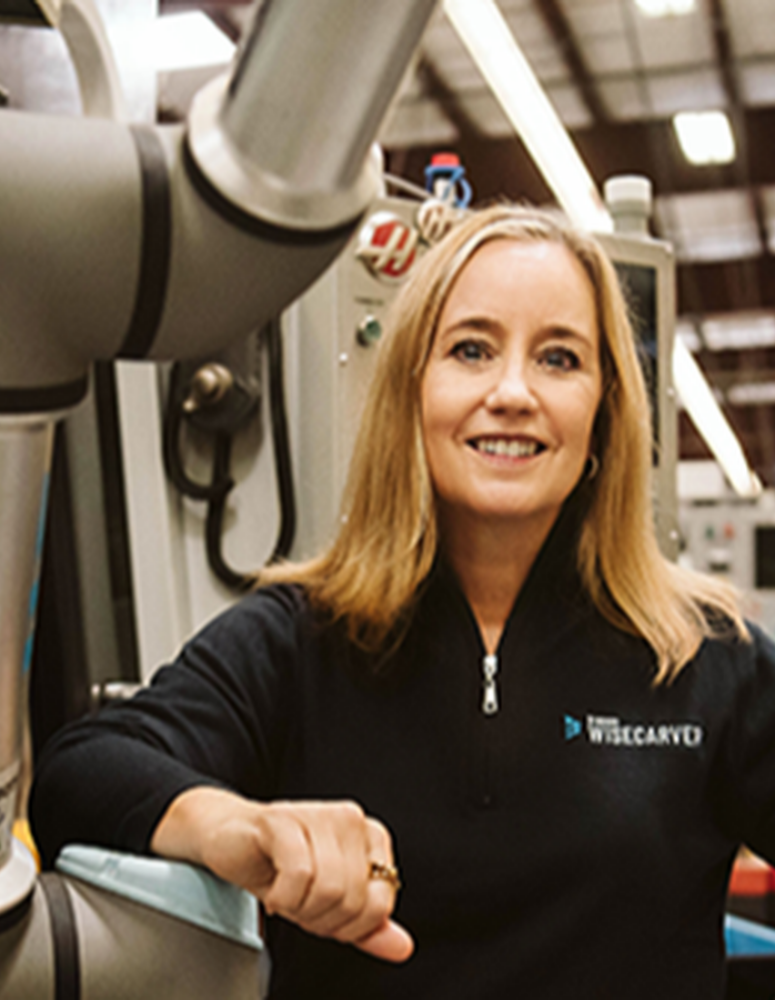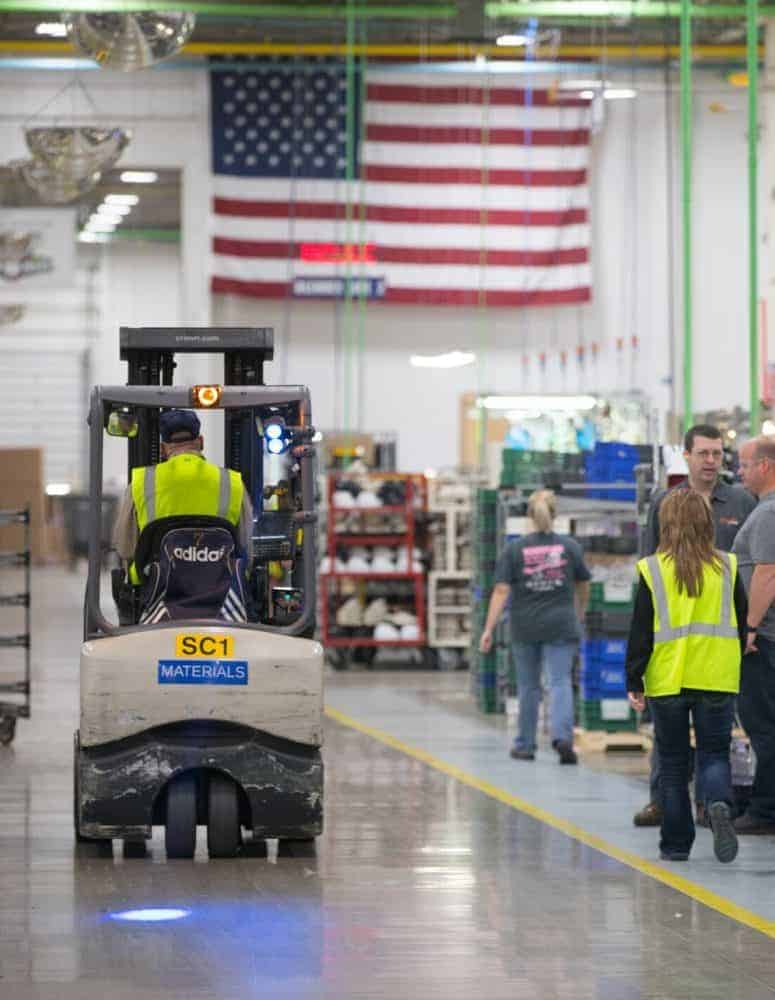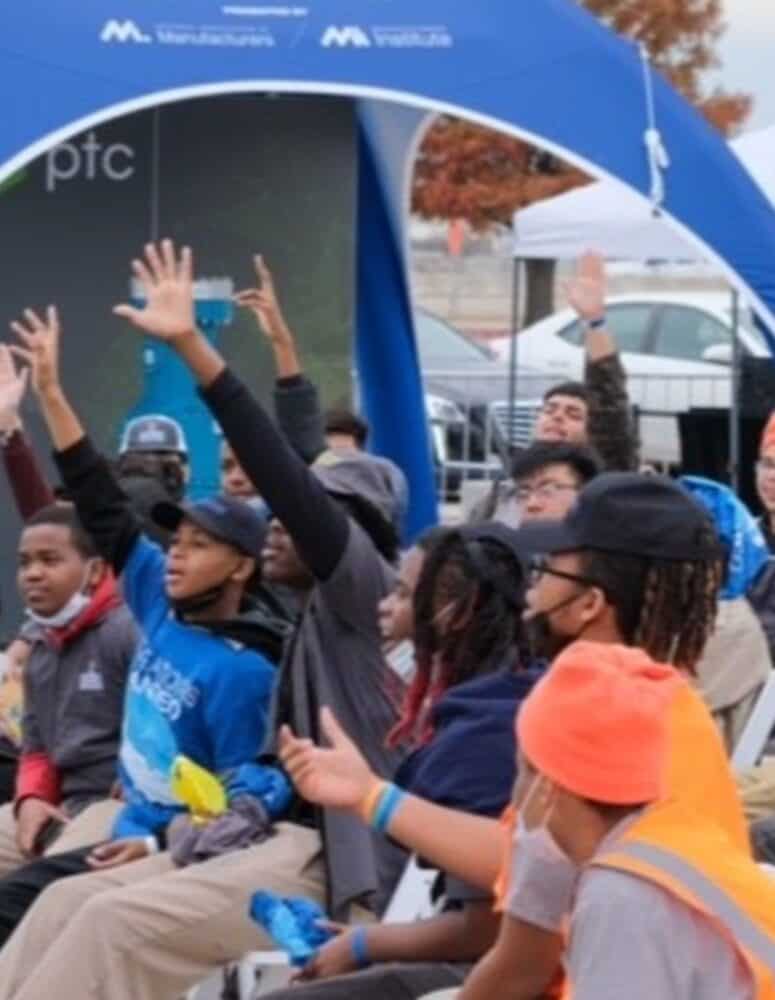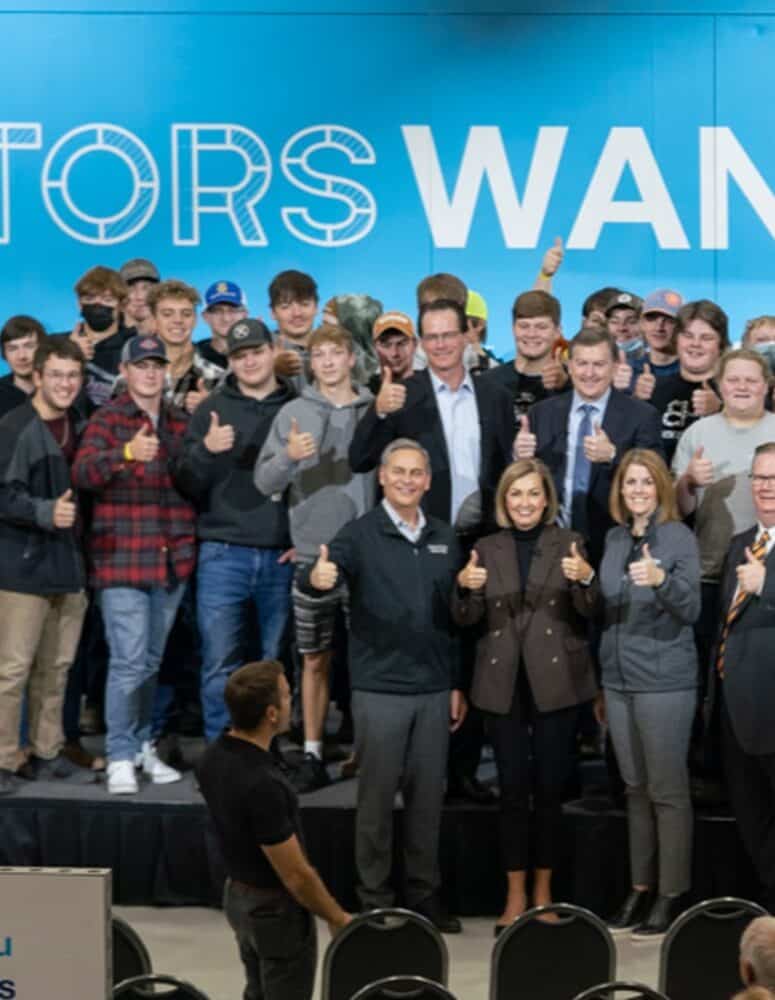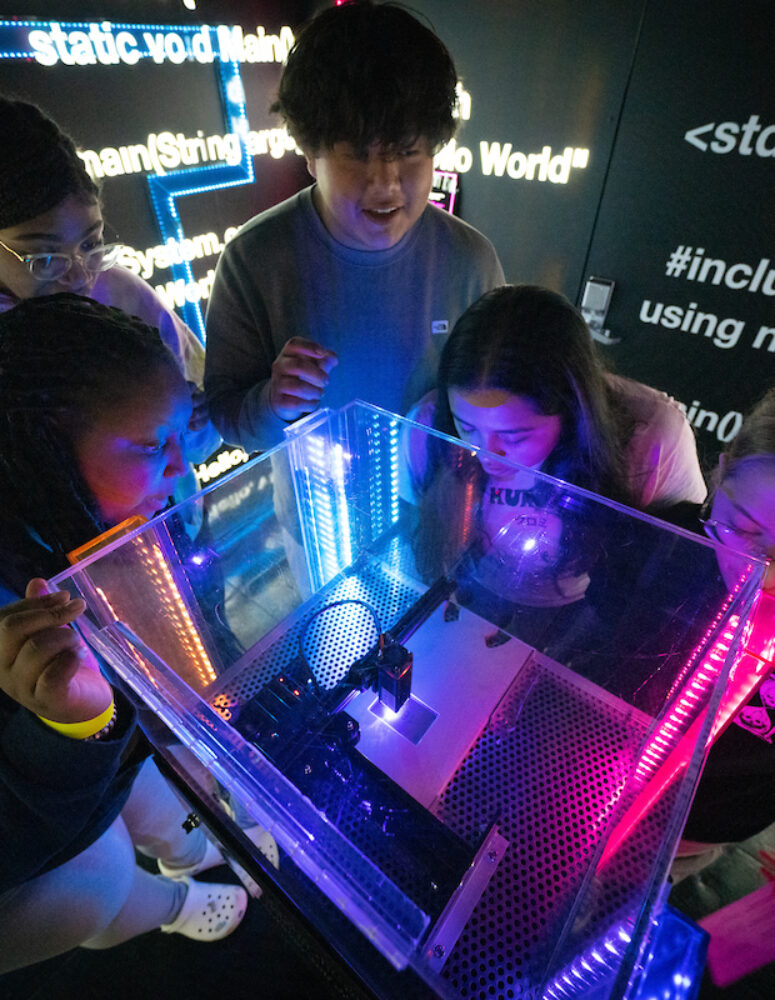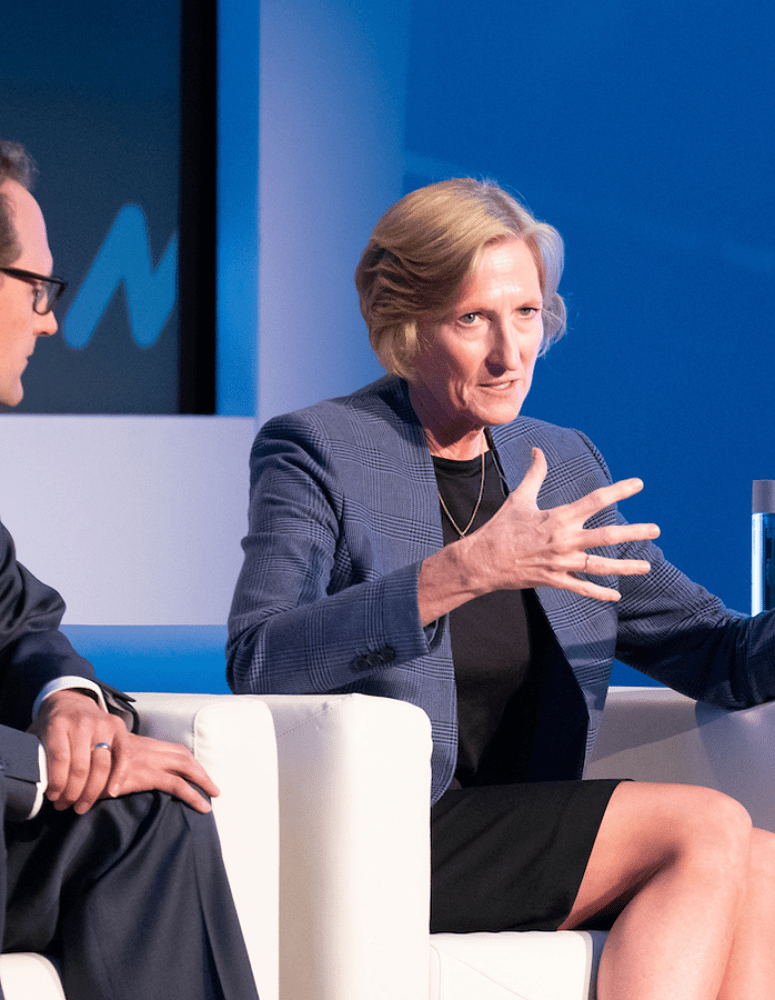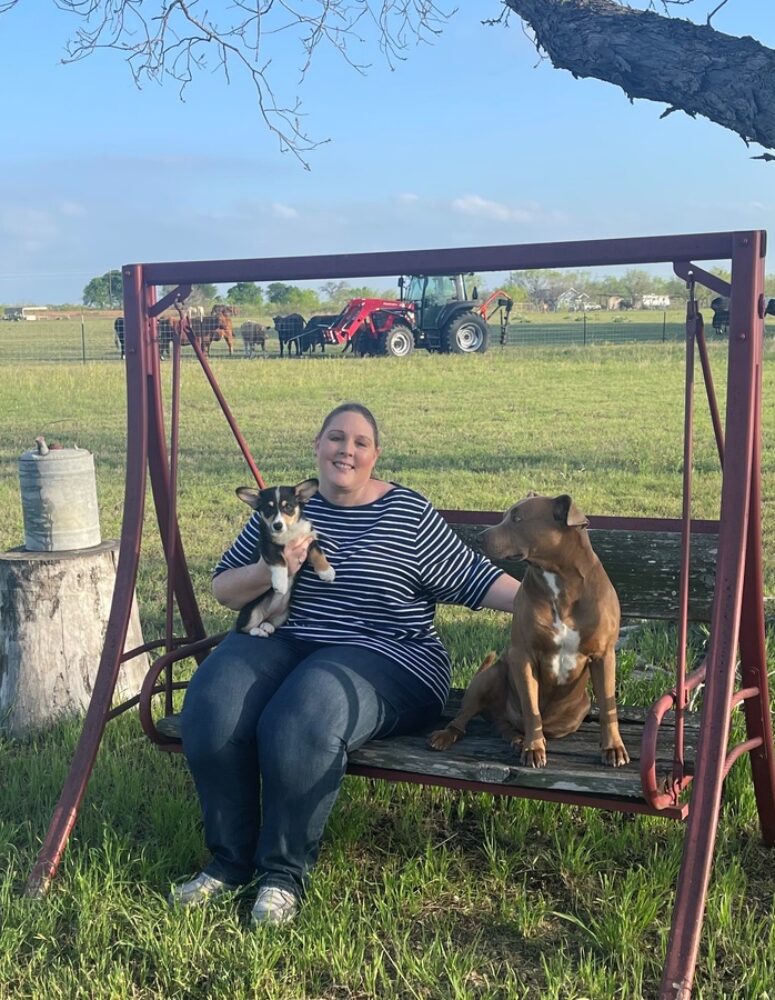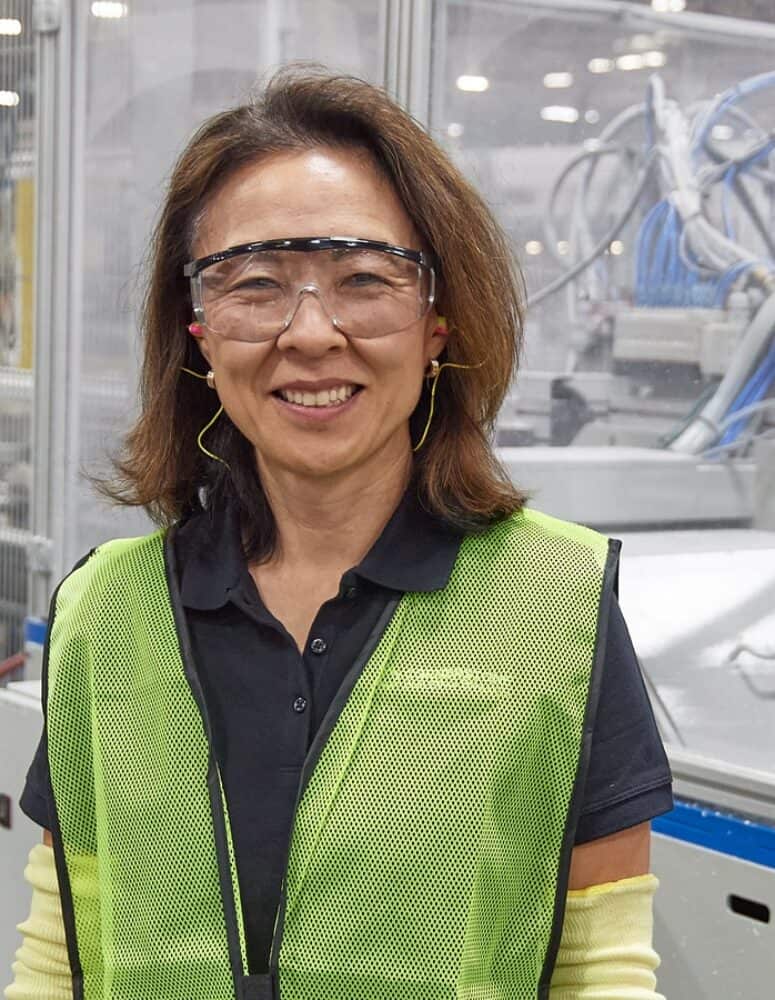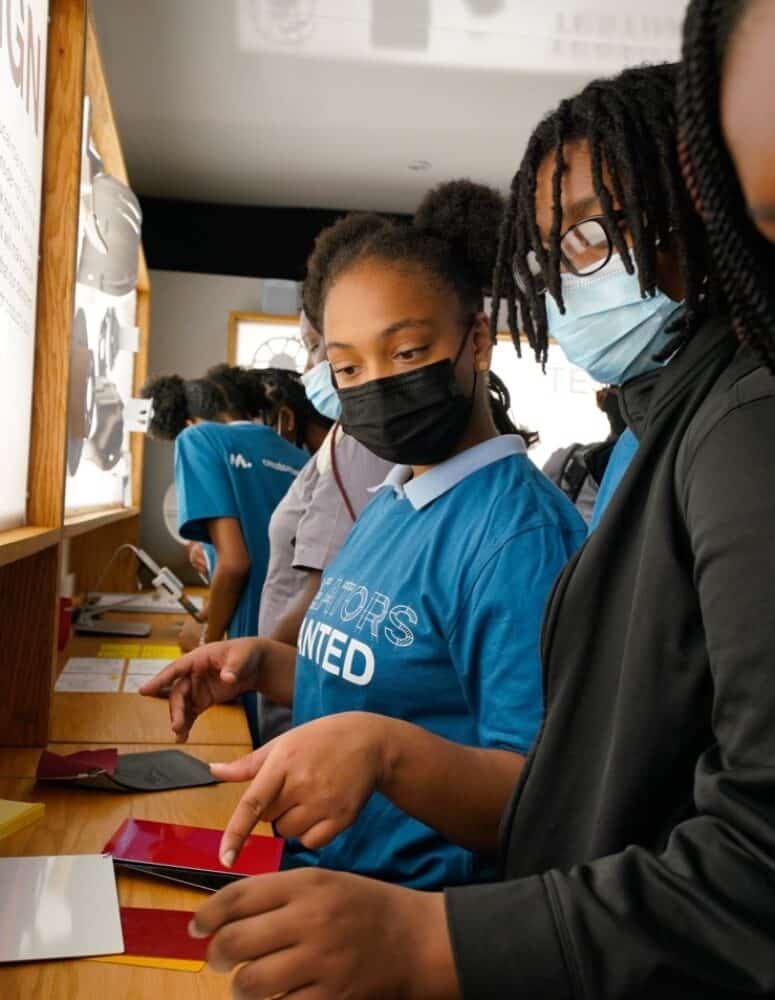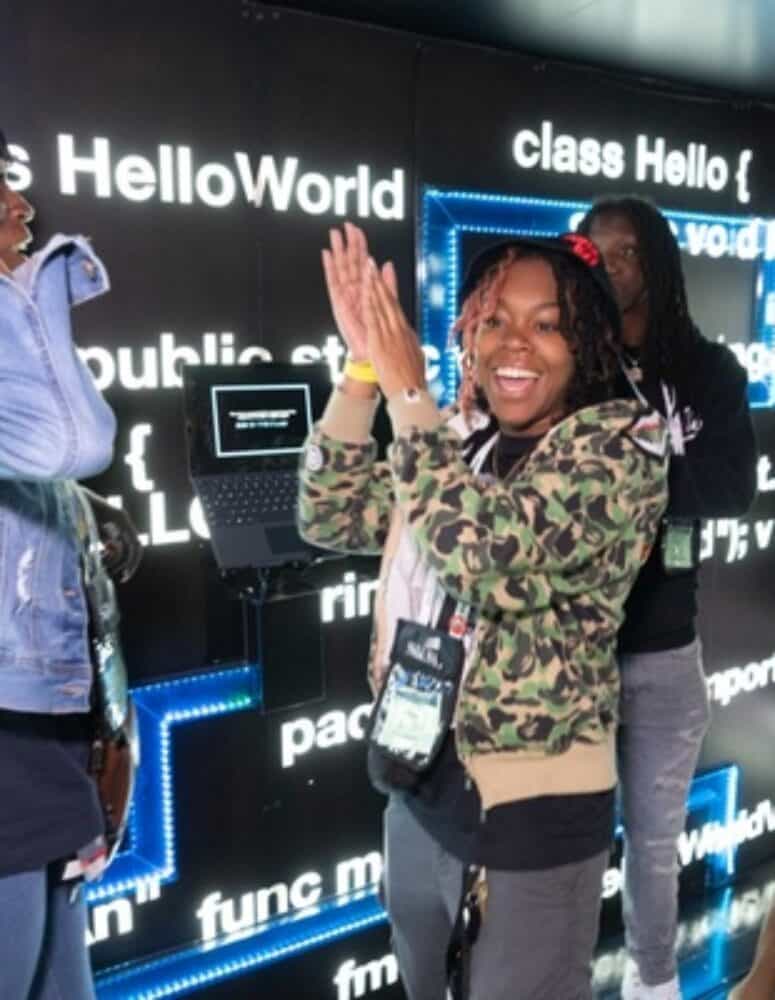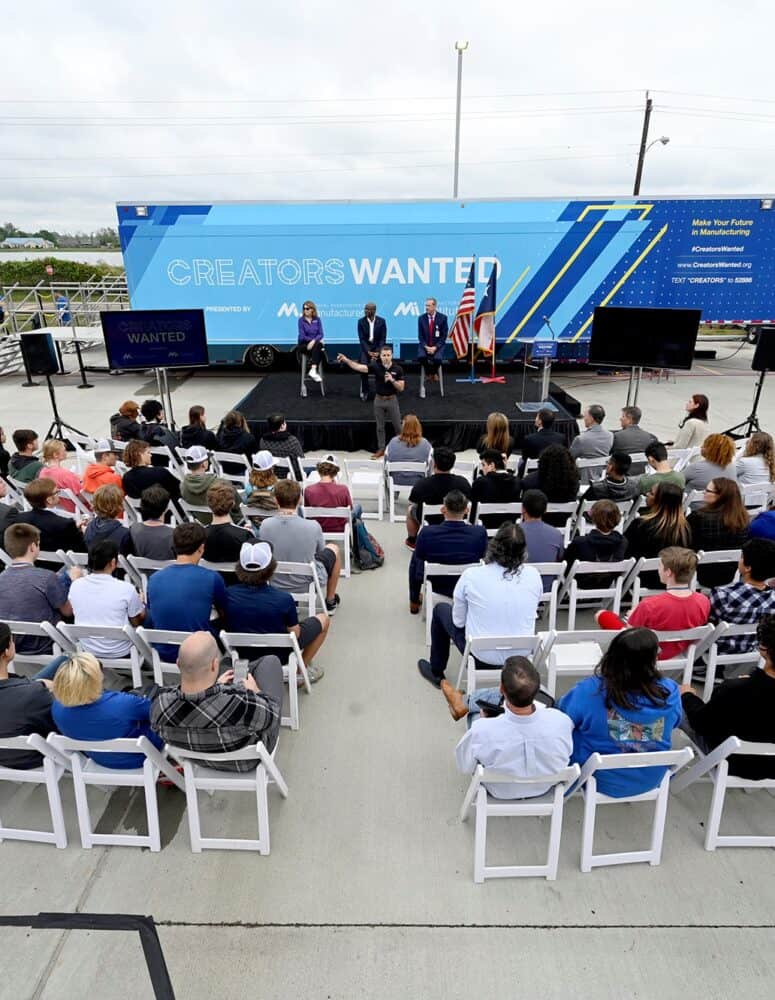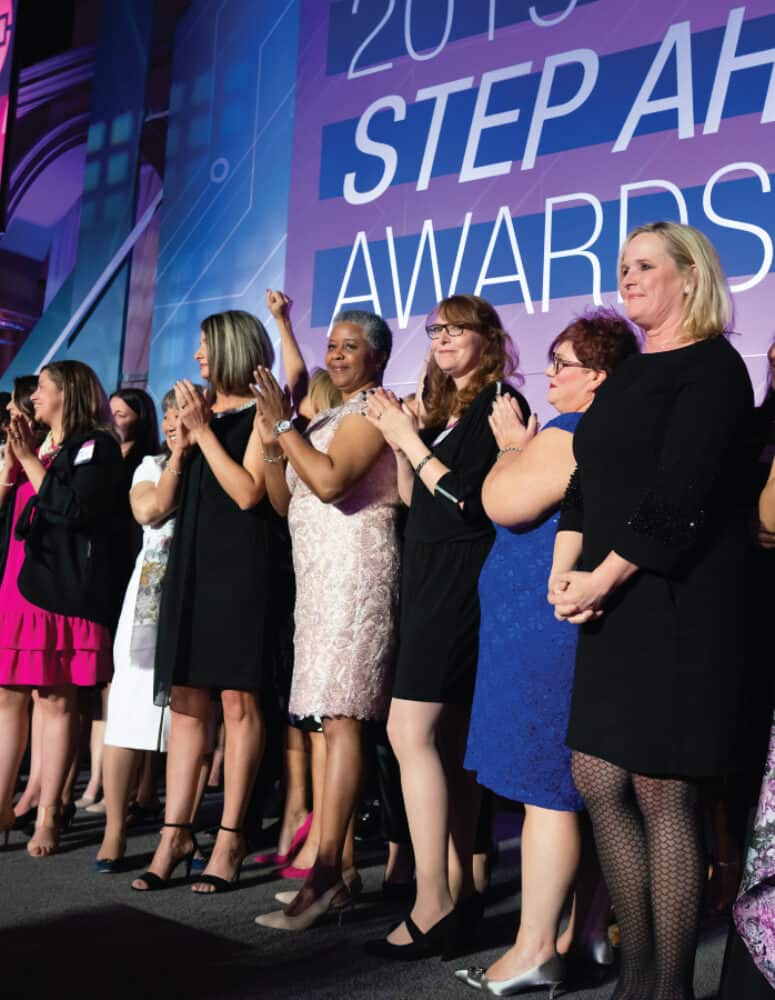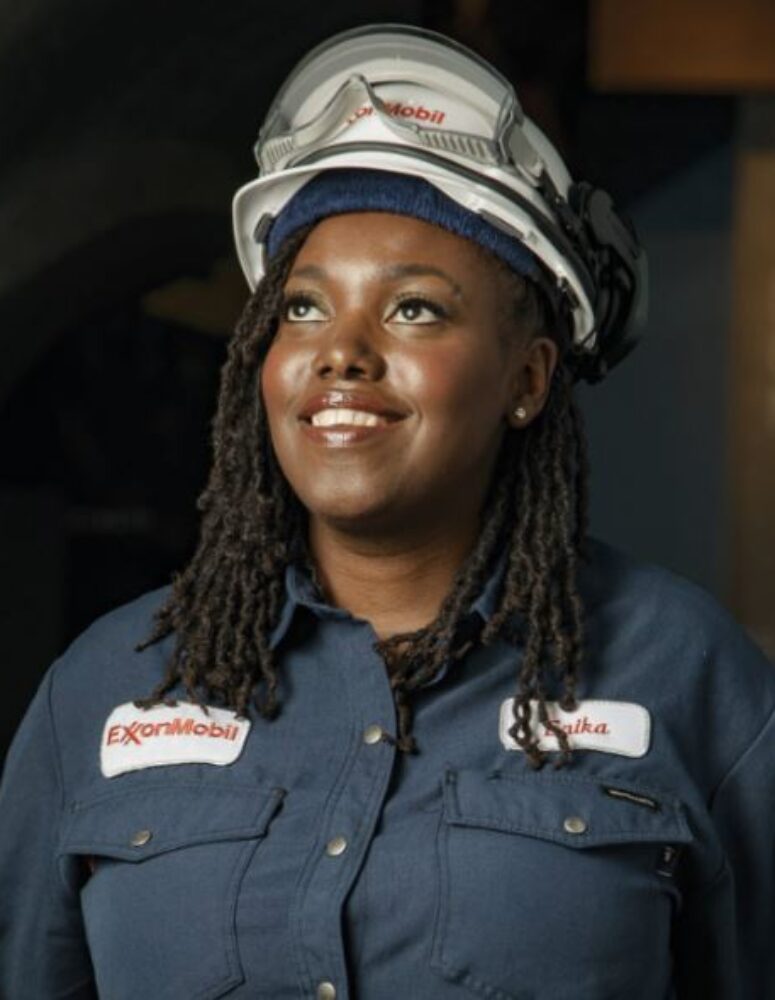A New Project Translates Military Experience for Manufacturing Employers
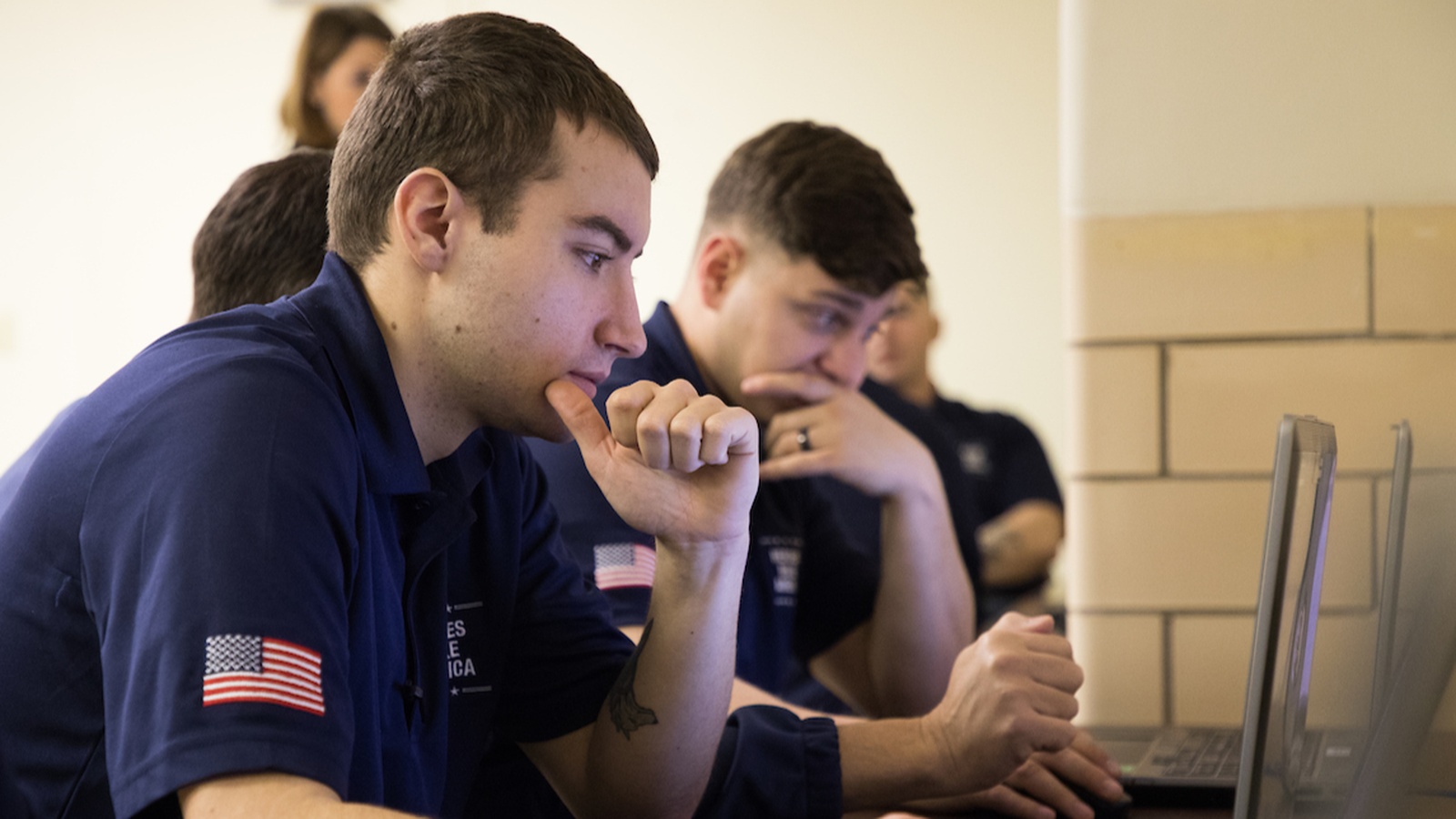
Manufacturers have long sourced great talent from the military community, helping transitioning and former military members apply their skills to America’s most pressing manufacturing challenges.
Through the Manufacturing Readiness Project, the Manufacturing Institute is now making it even easier for military veterans to find excellent civilian careers—and for manufacturers to build an outstanding and talented workforce.
The project: The Manufacturing Readiness Project aims to make military experience comprehensible to civilian employers via a digital credentialing system.
- Military servicemembers are awarded digital badges—stored in digital wallets—based on their military occupation and the training they received, giving both them and future employers a clear way to understand how their military experience prepared them for a career in manufacturing.
The details: The badges include a range of certifications in areas like general safety, general quality and general maintenance.
- Each badge includes a number of additional micro-badges signifying levels and types of achievement. General safety, for example, includes micro-badges in fields like workplace safety, environmental inspections and emergency response.
- These badges are also aligned with more than 300 military occupation codes across all five branches of the military, thereby translating military experience into terms that civilian employers will recognize.
What it means: For the MI, the workforce development and education affiliate of the NAM, this project represents a critical opportunity to expand the military-to-manufacturing pipeline.
- Currently, the MI’s Heroes MAKE America program trains transitioning military personnel in manufacturing skills and works to connect veterans to opportunities in manufacturing.
- The Manufacturing Readiness Project will enhance this effort by providing an avenue for veterans and transitioning personnel to highlight their military experience and enter the MI’s military-to-manufacturing pathway.
Why it matters: This initiative is one of the first of its kind to combine the use of the newest labor market technology tools—Learning & Employment Records, digital badges and digital wallets—to help workers find employment.
- This project is designed to be scalable across military occupations and civilian industries, thus opening the door to a broader range of servicemembers, veterans and employers.
What to expect: The pilot launched on Nov. 13—and within the first few weeks, more than 400 total badges have been awarded to transitioning and former servicemembers.
- So far, the initiative has received vital support from a range of organizations, including Solutions for Information Design, Jobs for the Future, Hire Heroes USA, the Manufacturing Skill Standards Council and Walmart. Following the pilot, the MI looks forward to seeking even more partners across the industry.
Learn more: For more information about the Manufacturing Readiness Project and the MI’s Heroes MAKE America program, please contact [email protected].
How Manufacturers Can Benefit from Military Talent
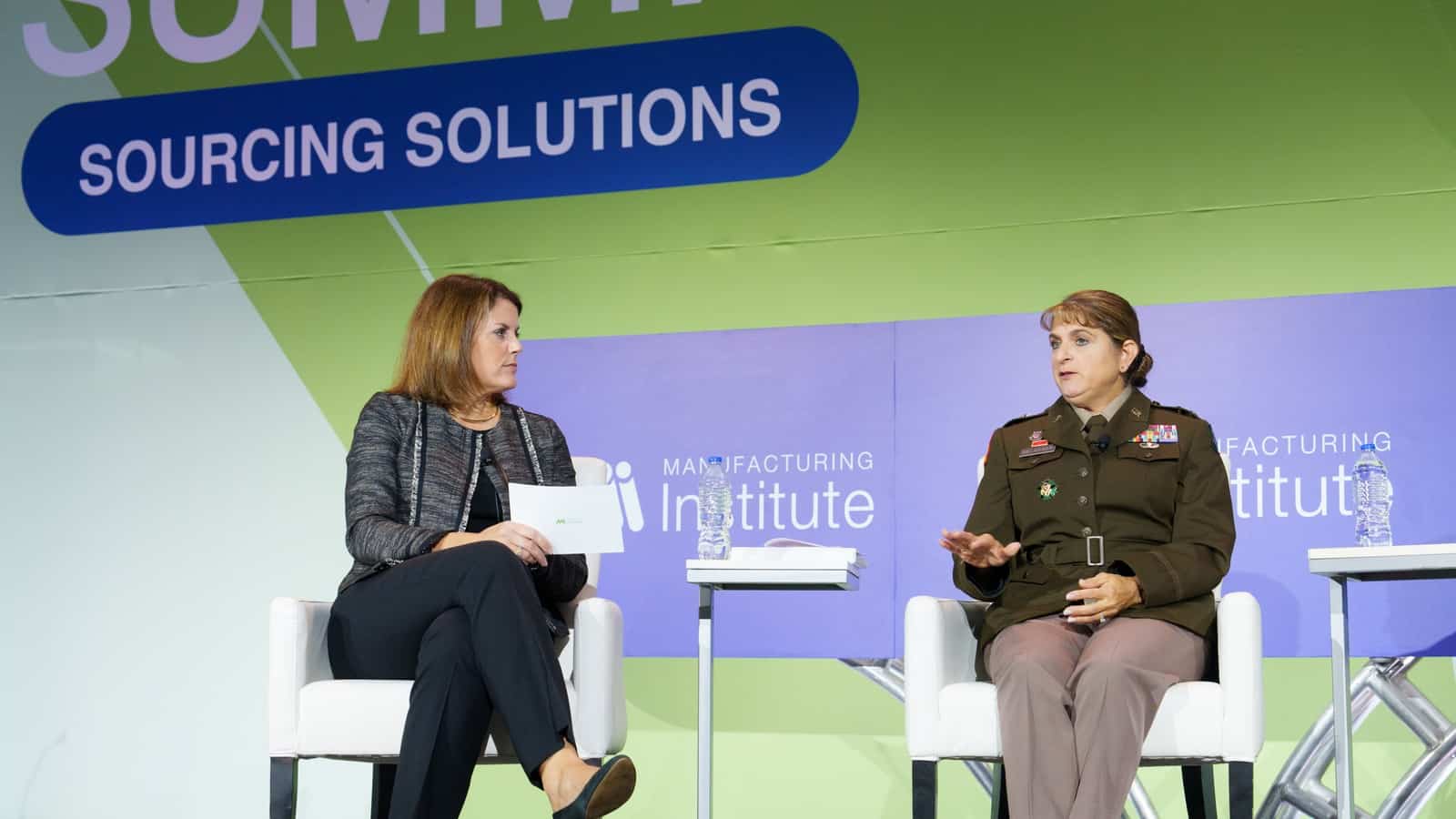
Looking for committed, disciplined employees to add to your workforce? In honor of Veterans Day, we’ll be highlighting how recruiting military talent—whether transitioning service members, veterans, National Guard members, reservists or military spouses—can help manufacturers address structural workforce shortages.
A productive match: At the Manufacturing Institute’s annual Workforce Summit in October, Maj. Gen. Kris A. Belanger, commanding general of the 99th Readiness Division, Army Reserve, spoke about the results manufacturers and military talent can achieve by working together.
- “The military offers diverse talent, very diverse. There are lots of ways that our training, roles and responsibilities overlap with those in manufacturing. Hiring military talent is a win–win situation,” she emphasized.
Making connections: During the “Leveraging Military Talent to Source an Essential Workforce” breakout session, MI National Director of Military and Veterans Initiatives Amy Thomas discussed how manufacturers can widen talent pipelines to include those affiliated with the military.
- “The Heroes MAKE American initiative trains and support military talent as they find a new career that utilizes their military training and experiences,” she said.
- “Since 2018, Heroes MAKE America has issued more than 6,000 industry-recognized certifications, achieved a 90% placement rate among graduates in more than 350 companies in 48 states and has shared information about manufacturing careers with more than 12 million individuals from the greater military community through social media, [Department of Veterans Affairs] newsletters and virtual and in-person industry events,” she continued.
Dive deeper: In addition to the Workforce Summit sessions, the MI held a Solution Series workshop in July to help manufacturers connect with military talent. The workshop offered manufacturers practical, actionable advice.
- For example, manufacturers should make sure the requirements listed in position descriptions are truly required for successful fulfillment of that role’s responsibilities, so that candidates coming from nontraditional backgrounds (such as military service) know they are welcome to apply.
- Companies should also make sure they know what military ranks and designations mean in terms of skills. They can go to the Civilian Leadership Equivalency Handout for guidance.
- For more tips, check out the MI’s Top 10 Solutions to Connect with Military-Affiliated Talent.
The last word: In conversation with Maj. Gen. Belanger, MI President and Executive Director Carolyn Lee noted, “With nearly 200,000 service members transitioning out of the military each year, the MI realized this was an opportunity to tap into that talent pool, teach them about manufacturing and bring them into our industry. That’s what makes our HMA program so exciting. We’re building those connections and providing those solutions.”
Get involved: Interested in learning more? Join the HMA team on Nov. 20 from 3:30 p.m. to 4:30 p.m. EST to learn how manufacturers can get involved in the program and benefit from this talent pool.
Thermo Fisher Scientific Opens Doors—and Career Paths—to Students on MFG Day
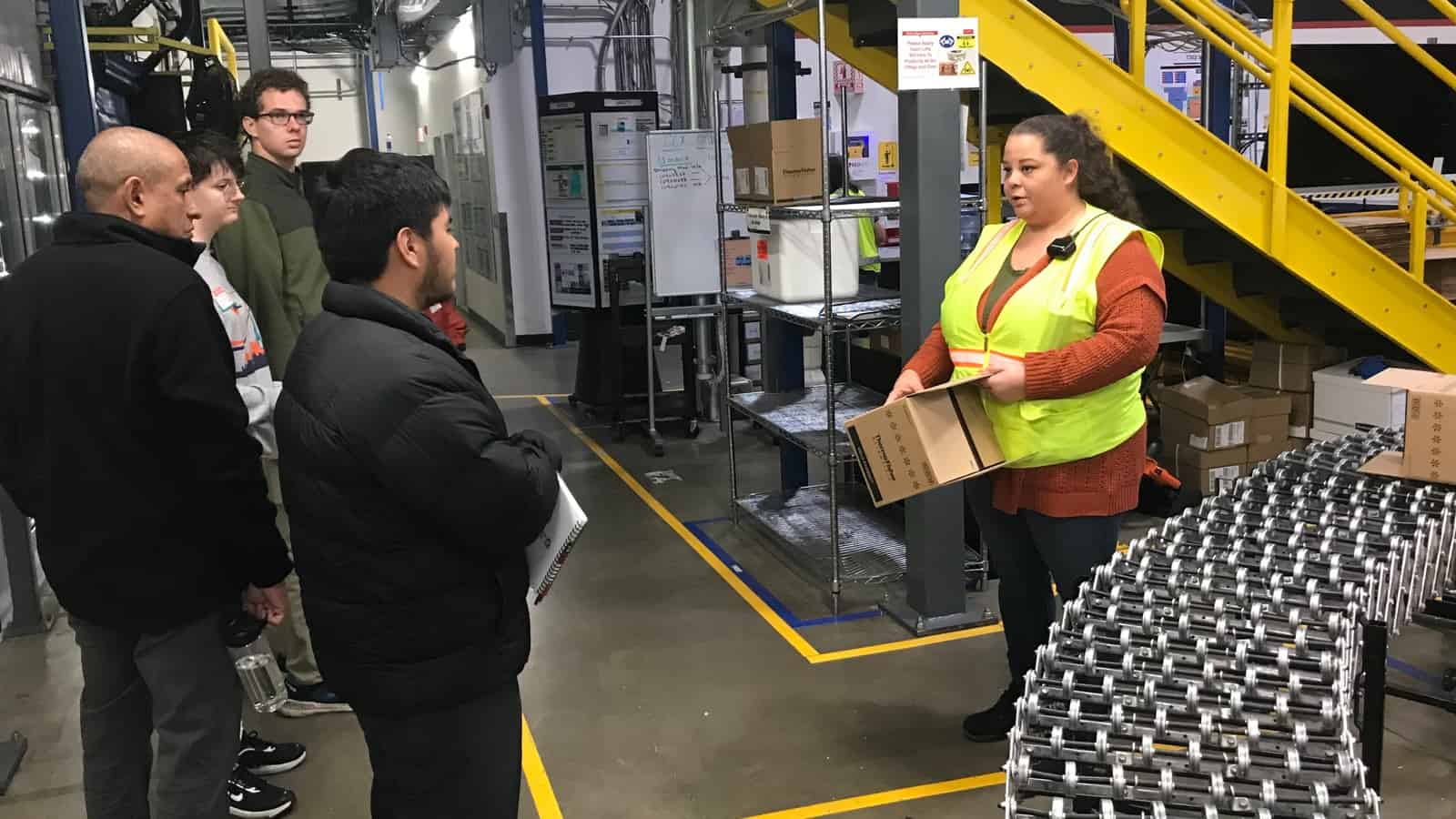
If you’re a jobseeker, Thermo Fisher Scientific wants you to know there are a plethora of job opportunities available at the company whether you have a science or engineering background or not.
At a well-attended MFG Day event for college students at its Frederick, Maryland, campus in October, both attendees and current employees said they were amazed to learn of the wide array of positions available at Thermo Fisher, a maker of life-sciences solutions and equipment.
Choose your own (career) adventure: “There’s a lot of opportunities here,” said Jude Ankrah, a cyber security engineer at the company’s Frederick location and one of the MFG Day’s event ambassadors, who helped lead student tours. “You can … make your own opportunities. There’s so much [internal] career movement. And it’s so flexible.”
- The MFG Day event drew about 60 students from four local colleges. It consisted of tours of the site’s distribution center, research-and-development cell biology building and corporate infrastructure and security center.
- Juan Argueta, who is working toward a cybersecurity degree at Frederick Community College, said he hadn’t expected the life-sciences giant to need people with his expertise.
- “I found out about it at school. I checked [the website], and there are actually a lot of openings in cybersecurity here,” Argueta told the NAM. “So I decided to come. There are so many great benefits [at Thermo Fisher]—including tuition reimbursement—for employees.”
Science not required: It’s a widely held misconception that people working at Thermo Fisher are all scientists and engineers, said Lisa Sweeney-Walker, senior executive assistant to Chief Scientific Officer Dr. Karen Nelson.
- “You don’t have to have a Ph.D. [or even] a science background” to get hired at Thermo Fisher, she said. “We have human resources, we have warehousing positions, we have other things.”
- In fact, the Frederick campus’s largest number of job openings is in manufacturing and distribution, said Frederick Site Leader and Senior Director of Manufacturing Operations Keith Howell, who spoke before the site tour. “We need both college-educated and non [degree-holding] hires,” he said.
Great strides: Thermo Fisher is doing some amazing things in science—and MFG Day attendees were able to watch some of its operations through interior windows at the R&D cell biology building.
- There, chemists are working to create “shells” for the next mRNA vaccines, Thermo Fisher Director of R&D David Kuninger told event attendees.
- Scientists at the company—who developed many of the tools involved in CAR T-cell therapy, a cell-based treatment technique in which a patient’s own T-cells are “programmed” in a lab to find and fight cancer cells—are now engineering an immune cell to fight cancer, he continued.
A path at Thermo Fisher: Regardless of your career interests, you’re likely to be able to pursue them at Thermo Fisher, said Shayne Boucher, a staff scientist in cell and gene therapy at the company.
- “Everyone has their own unique path,” he told the students. “There is an opportunity here to find out what works for you.”
Inside the MI’s Pathbreaking Workforce Summit
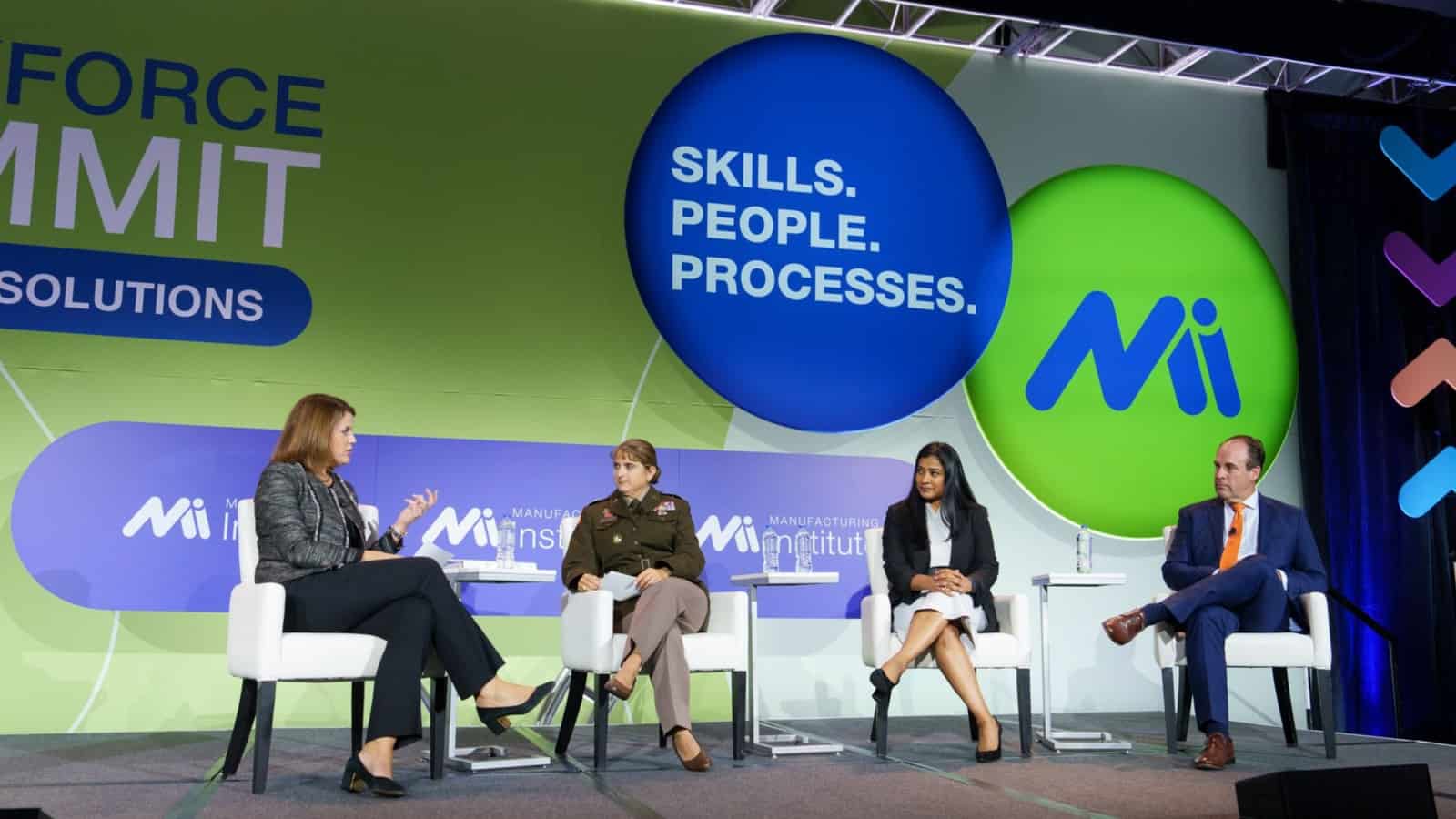
The best minds tackling manufacturers’ workforce challenges gathered in Atlanta last week to discuss hiring, retention, training and more. The Manufacturing Institute’s workforce summit convened almost 300 manufacturers, partners from education and training groups, philanthropy leaders and representatives from community-based organizations to share insights and brainstorm solutions.
The economic backdrop: Amid a persistently tight labor market, manufacturers are looking for immediate and long-term solutions to attraction and retention challenges.
- Chad Moutray, director of the MI’s Center for Manufacturing Research, provided the larger economic context for attendees, saying that “it’s not hard to be bullish about manufacturing. There continues to be signs of resilience in the sector despite a multitude of challenges.”
- “However, it exacerbates workforce issues, which remain the top concern of manufacturers, especially in a solid labor market,” he added.
Energizing connections: The MI was focused on helping participants learn from each other and form lasting and productive bonds.
- Organizations including the Georgia Association of Manufacturers, Siemens Foundation and River Parishes Community College sent leaders to facilitate conversations and share insights, while the generous support of WestRock, the Arconic Foundation and many others made the event possible.
- In breakout sessions, MI experts analyzed the key challenges facing manufacturers and shared proven workforce solutions like high school internships, female mentorship programs and regional sector partnerships.
Fresh insights: The two-day event was brimming with new ideas and fresh perspectives—too many to list in one article. Here is a brief sampling of the topics covered:
- People: The speakers highlighted manufacturers’ work to create positive company culture, prioritize flexibility and address issues like the shortage of child care. Maj. Gen. Kris Belanger also shared the importance of tapping into military talent pools like the U.S. Army Reserve. Programs like the MI’s Heroes MAKE America are making these important connections.
- Skills: To meet their needs for skilled workers, manufacturers are working with the MI, economic development boards and educational institutions to train the current and next generations of manufacturing employees. Workshop sessions showcased solutions from the MI’s FAME USA program, second chance hiring initiative and student engagement.
- Processes: Conversations in the popular “Brewing Solutions” rooms focused on ways manufacturers and workforce partners could tap into hidden populations, create attractive working environments and address policy barriers that restrict the adoption of innovative solutions.
Fearing you missed out? Don’t worry! There are plenty of ways you can plug into the cutting-edge work of the MI, the NAM’s workforce development and education affiliate.
- Get updates directly from the MI on the latest workforce insights and receive information about registering for the 2024 Workforce Summit.
- Join us as a sponsor for the 2024 Women MAKE Awards in Washington, D.C., on April 18 to support female manufacturing leaders and network with manufacturers and other workforce partners.
- Want more labor data and insights? Sign up for the MI’s comprehensive Workforce in Focus newsletter to stay up to date on the latest workforce trends.
The last word: “The MI’s unique positioning as both an insightful expert of emerging trends within the industry and an effective implementer of proven workforce solutions drives innovative problem-solving,” said MI President and Executive Director Carolyn Lee. “As we face structural workforce shortages, convenings like the MI’s Workforce Summit will continue to be crucial to build the types of partnerships and share important insights needed to ensure the readiness of the manufacturing workforce.”
Creators Wanted Tour Sets New Records at Ohio Finale

The size of the Great Pumpkin at the 116th annual Circleville Pumpkin Show—Ohio’s iconic fall fest—wasn’t the only record shattered there last week. The Creators Wanted Tour, a historic initiative of the NAM and the Manufacturing Institute to build excitement about modern manufacturing careers, reached new highs for engagement at its 20th and final stop.
Driving the news: The show attracted a crowd of more than 400,000, with “Creators Wanted” the most prominent brand seen and heard throughout the entire event. Of show attendees, the Creators Wanted activation pulled in a tour record of 2,024 participants comprising students and chaperones, taking the immersive experience’s overall total to just shy of 17,000 in two years.
- The digital campaign surrounding the stop collected an additional 110,000 email signups from students and career mentors interested in learning more about modern manufacturing careers, bumping the campaign’s email list above 1.6 million.
- The tour stop also saturated local news, with NBC4, 10TV CBS and WTTE Fox all sending live crews to the experience.
Why it matters: The stop, sponsored by the joint venture of Honda and LG Energy Solution and in partnership with the Ohio Manufacturers’ Association, comes at a critical time for the nation’s manufacturers, as they compete against other industries to fill available job openings today and win the interest of young people for the careers of tomorrow.
- For example, Honda and LG Energy Solution need to hire 2,200 workers within two years for their new electrical vehicle battery plant in Fayette County, Ohio.
- At the stop, Honda and LG Energy Solution joint venture associates were on hand to provide information about modern manufacturing careers generally and about opportunities at the EV plant specifically. The traffic around the experience was so robust that all recruiting materials were exhausted before the event wrapped up.
Zoom in: On Saturday night, the Creators Wanted team also reinforced the industry’s commitment to communities by leading the largest parade of the show, in front of tens of thousands who heard the public address system broadcast the industry’s call for creators and highlight the campaign’s career resources at CreatorsWanted.org.
- NAM President and CEO Jay Timmons, a proud son of Circleville and Chillicothe, Ohio, also addressed an assembling of Ohio’s young women leaders and their families, emphasizing their capacity to make a difference in manufacturing careers while at the same time noting mentorship resources available to them through the MI’s Women MAKE America initiative.
- The tour’s innovative approach received strong approval from state and local officials, strengthening the campaign’s ability to reach students and constituents. Ohio Treasurer Robert Sprague, State Auditor Keith Faber, State Sen. Michele Reynolds and State Reps. Brian Stewart and Mark Johnson, among others, stopped by to see what the buzz was all about.

Tour highlights: Beyond the pumpkin-centric celebrations, the tour also took its message of opportunity and rewarding careers to the new, state-of-the-art Logan Elm School, a combined elementary, middle and high school, as well as to students of the Ohio State University’s Center for Design and Manufacturing Excellence.
- At Logan Elm, Timmons was joined by OMA President Ryan Augsburger, Honda and LG Energy Solution joint venture representative and engineer Sandip Suvedi and representatives from Sofidel America. Honda engineer Meredith Reffey, who is now Honda America’s department lead for workforce partnership, joined Timmons and MI President and Executive Director Carolyn Lee at OSU. (The MI is the workforce development and education affiliate of the NAM.)
The big number: Post-tour surveys show that 84% of participants now view the manufacturing sector more positively.
On the record: “Closing our expansive 20-stop, 25,000+ mile tour at such a dynamic event serves as a potent reminder: the heartbeat of manufacturing lies within our communities,” said Timmons. “It’s in the eyes of the young dreamers in the crowd, the hands of our diligent staff and the spirits of every individual who championed our journey.”
- “The Creators Wanted Tour helped us shift perceptions, but we also know the hard work of continuing to improve perceptions and build the workforce of the future goes on,” said Lee. “The Manufacturing Institute, with our scaled-up efforts to drive solutions with manufacturers and across the industry and the robust digital network and resources the campaign has created will build on the tour’s momentum to do even more.”
The last word: “Our aspiration with Creators Wanted was straightforward yet audacious: to transcend traditional boundaries, step out of the corridors of Washington, D.C., and engage directly with communities across the country,” said NAM Managing Vice President of Brand Strategy Chrys Kefalas. “That’s exactly what we and the manufacturers who joined this tour and campaign did, and we’ve made a lasting positive difference in people’s lives that will outlive this tour and help the industry for decades to come.”
A Supply Chain Leader Supports Other Women in Manufacturing
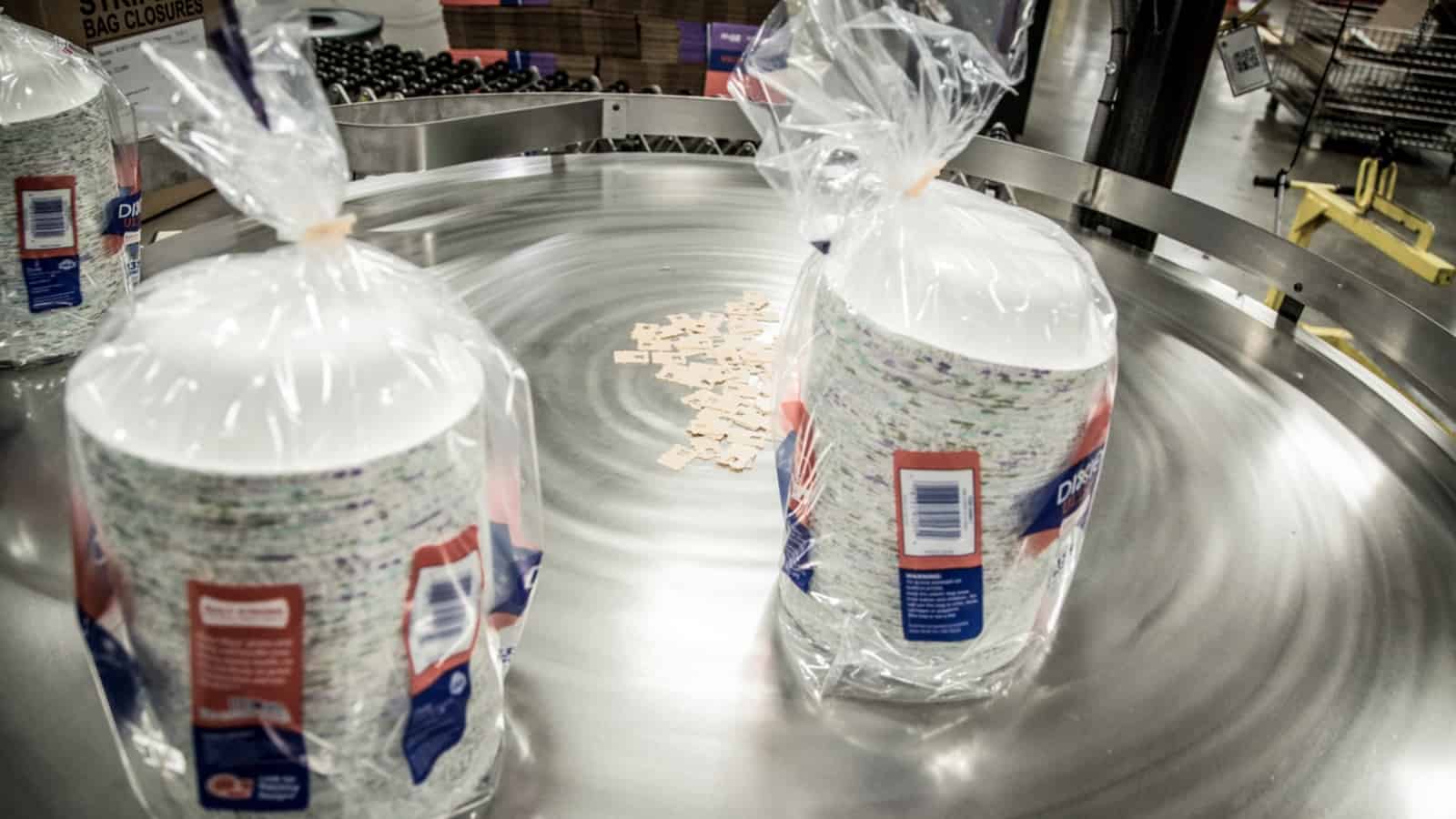
When Carrie Shapiro began her career as an engineering student at the Georgia Institute of Technology, she didn’t expect to work in manufacturing—but the moment she walked into a manufacturing facility near her school for an interview, she was hooked.
“I’ve had so many opportunities in manufacturing that I never wanted to leave,” said Shapiro. “From the very beginning, I was able to keep learning and growing and making better relationships.”
Today, Shapiro serves as the vice president of sourcing execution at Georgia-Pacific—a pulp and paper company—where she guides procurement and uses her expertise in supply chain operations to benefit the company’s 110 facilities. As a leader in the industry, she’s also focused on helping potential creators understand all that manufacturing has to offer.
A changing world: Shapiro’s role has been especially important over the past few years, as the COVID-19 pandemic and its aftermath forced companies to adjust their supply chains and react to shortages in real time. For Shapiro, that process required rethinking risks, using data effectively and focusing on achieving stability before optimization.
- “The mistake that we often make is we try to optimize something that’s not stable,” said Shapiro. “If you’ve got chaos in your supply chain, you have no business trying to optimize it. You have to stabilize first.”
A need for humans: As Shapiro notes, data has become more readily available than ever before, and new tools are helping organizations make smart adjustments in real time. Yet, human decision-making and critical thinking still have a vital role at the center of manufacturing.
- “Tools are great, software is great, tech is great—but it should be an enabler and not a magic wand,” said Shapiro. “You still have to know your process, understand your current state and know your capabilities across the supply chain to make effective decisions. Tools don’t absolve you from doing the real work of continuous improvement.”
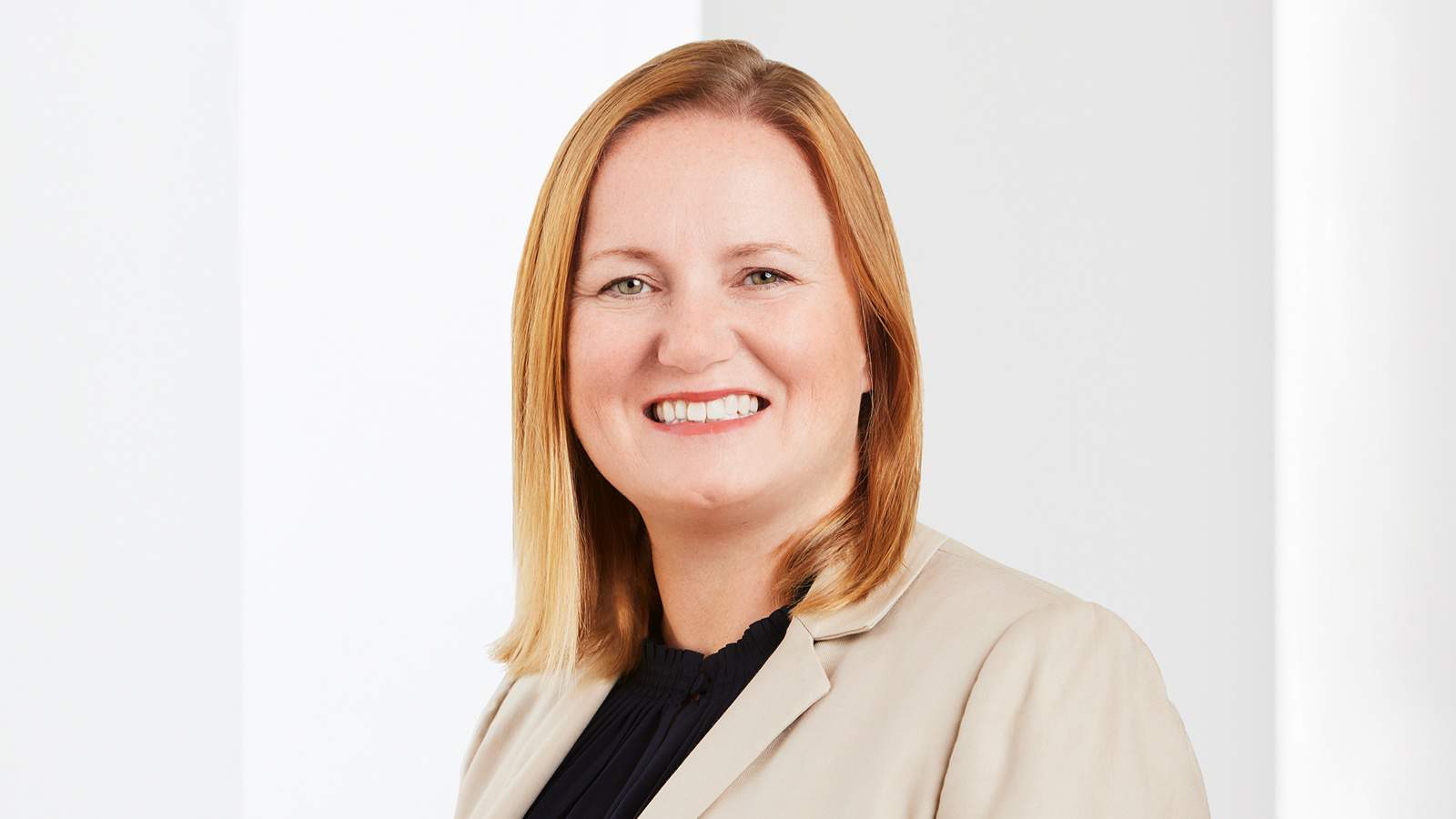
Leading by example: At a time when women are underrepresented in the manufacturing industry, Shapiro feels a responsibility to help other women succeed.
- She serves as a mentor with Pathbuilders, where she helps high-achieving women reach their fullest potential. She also coaches young engineers in the Steven A. Denning Technology & Management Program at Georgia Tech and serves as a longstanding member of the Next Generation Manufacturing Women’s Roundtable.
- “One of the most important roles that I play is to be a visible leader and to show there is a path to leadership inside manufacturing as a female,” said Shapiro. “Having someone who looks like you in a leadership position really matters. That representation matters, and it’s meaningful to people coming up in the organization.”
- On the strength of her long record of mentorship, Georgia-Pacific has nominated Shapiro for a 2024 Women MAKE America award, given by the Manufacturing Institute (the NAM’s workforce development and education affiliate) to outstanding women in the field. (Stay tuned for the ceremony!)
The last word: Shapiro encourages other manufacturing leaders to be active in lifting up individuals who might otherwise be overlooked.
- “I’ve had incredible supervisors who have pulled me up through the organization, who saw something in me that I didn’t see in myself,” said Shapiro. “Sometimes people look at a candidate and think they might be a stretch for the position—but they may just not look like a traditional candidate.”
New Manufacturing Institute Study: How Firms would Invest a Marginal Dollar with their Company
Washington, D.C. – The Manufacturing Institute, the workforce development and education affiliate of the National Association of Manufacturers, in partnership with Cognizant, released a study that examined the different approaches manufacturers take in making investment decisions.
“As manufacturers continue to evolve, the nature of work and skills must adapt to meet the needs of the changing industry. Manufacturing leaders must prioritize investments to best position their companies in a competitive marketplace and set themselves up for success over the long term,” said NAM Chief Economic and Director for the Center of Manufacturing Research Chad Moutray. “Three investment priorities emerged across manufacturer size and industry: increasing throughput and lowering costs where possible, creating new opportunities for growth, and building a stronger, more resilient workforce. Nearly all the companies we interviewed emphasized the importance of investing in their workforce.”
The study consisted of an online survey and in-depth interviews of manufacturing leaders from June to August 2023.
The following are highlights of the report:
- When asked about their top priorities for current dollars, nearly 74% of manufacturers reported building a robust and trained workforce as a key area for investment, which fits in with the larger macroeconomic conditions of the tight labor market and shortage of available workers.
- When business leaders were asked how they would spend a marginal $1 million, 61.5% would invest in new equipment. These findings point toward a desire to make smart investments that will transform operations and the production process, while also ensuring that the workforce can adapt to such changes.
- Additional areas of focus for marginal dollar investment included investing in improved processes and operations (60.2%), optimizing existing equipment (53.4%), investing in new equipment (51.7%), investing in new technologies (46.6%) and research and development (44.9%).
- When considering their future growth strategies, manufacturers identified a stronger domestic economy for growing sales (69.5%), increased efficiencies in the production process (67.8%) and maintaining a robust and trained workforce (67.0%) as the most significant factors in contributing to expansion.
Key Takeaway:
From survey data and interviews, three investment priorities emerged across manufacturer size and industry:
- Increasing throughput and lowering costs where possible
- Creating new opportunities for growth
- Building a stronger, more resilient workforce
-The MI-
The Manufacturing Institute builds a resilient manufacturing workforce prepared for the challenges and opportunities of the future. Through implementing groundbreaking programs, convening industry leaders and conducting innovative research, the MI furthers individual opportunity, community prosperity and a more competitive manufacturing industry. As the 501(c)3 nonprofit workforce development and education affiliate of the National Association of Manufacturers, the MI is a trusted adviser to manufacturers, equipping them with solutions to address the toughest workforce issues.
733 10th St. NW, Suite 700 • Washington, DC 20001 • (202) 637-3000
Creators Wanted and Union Pacific Dazzle the Twin Cities
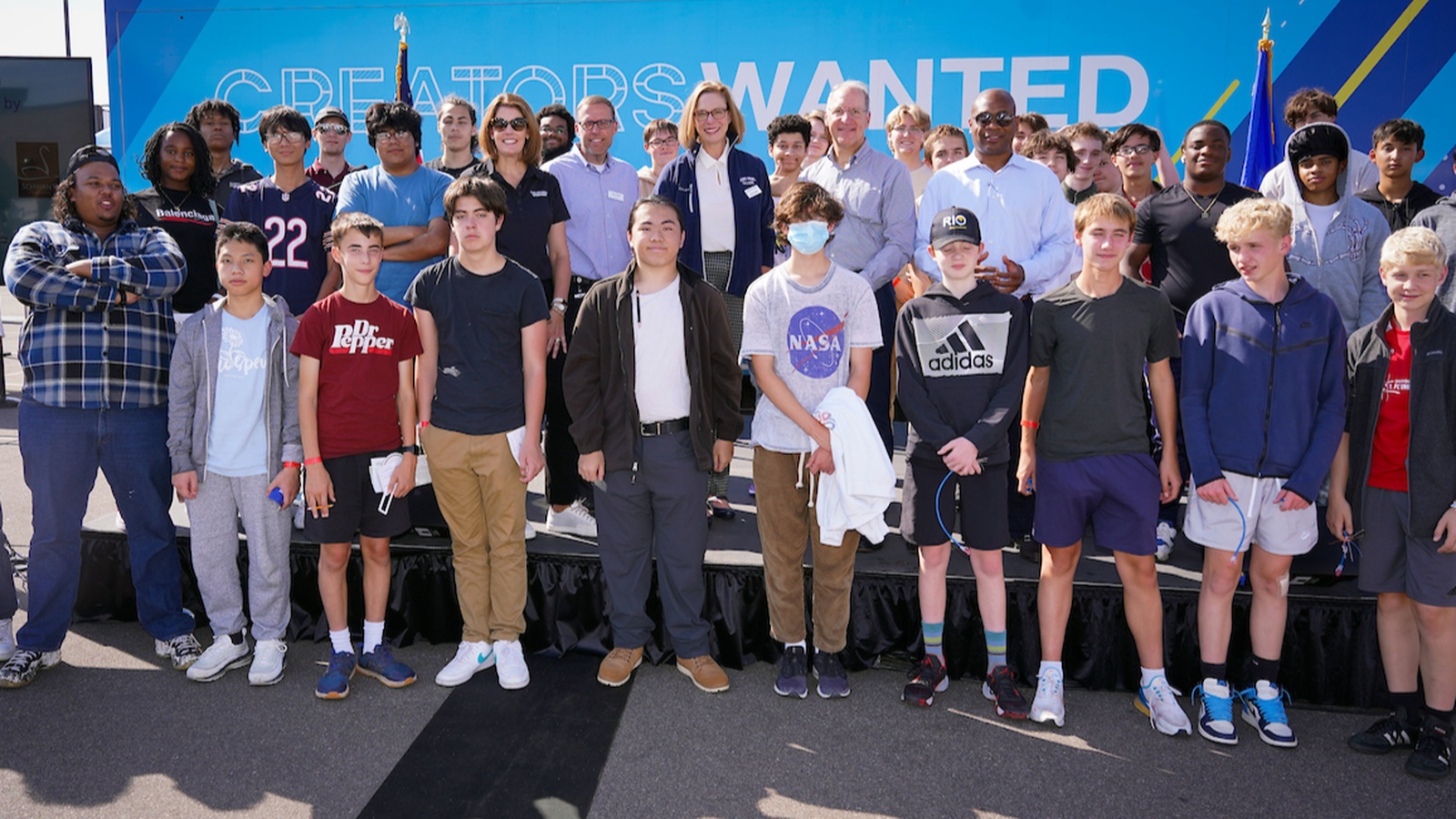
Last week, Saint Paul College in St. Paul, Minnesota, which boasts a student body that is 65% people of color, became the 19th stop of 20 for the Creators Wanted Tour, a joint project of the NAM and the Manufacturing Institute, the workforce development and education affiliate of the NAM.
Over three days, with Union Pacific as the lead sponsor, the stop drew more than 600 visitors, from students to educators. Meanwhile, 42,000 online signups in Minnesota helped the campaign surpass 1.5 million nationwide from students and career mentors interested in modern manufacturing careers.
Twin Cities kickoff: Union Pacific Executive Vice President of Marketing and Sales Kenny Rocker gave the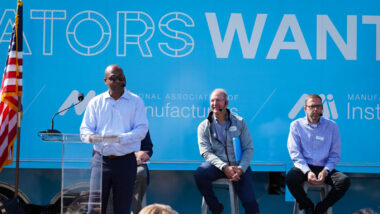 keynote address at the kickoff event, emphasizing the reward of manufacturing careers. He was joined by MI President and Executive Director Carolyn Lee, Saint Paul College President Dr. Dee Dee Peaslee, Minnesota Chamber of Commerce President and CEO Doug Loon and Trane Technologies Vice President of Product Management Dave Molin.
keynote address at the kickoff event, emphasizing the reward of manufacturing careers. He was joined by MI President and Executive Director Carolyn Lee, Saint Paul College President Dr. Dee Dee Peaslee, Minnesota Chamber of Commerce President and CEO Doug Loon and Trane Technologies Vice President of Product Management Dave Molin.
- “When I talk about opportunities, I’m talking about really good-paying jobs … At Union Pacific, we’re talking jobs that are … averaging over $100,000 a year, and that’s without benefits, and so you just really have an opportunity to make an impact from that perspective,” said Rocker.
- “At Trane Technologies, our vision is to boldly challenge what’s possible for a sustainable world,” added Molin. “It is the engine of our company, and we live it every day. And to do that, we need bright minds and the best minds in the world. We need diverse thinkers, we need creators, and our doors are open to everyone.”
- Notably, leaders from key government business and workforce partner organizations attended the kickoff, including the Minnesota State Advanced Manufacturing Center of Excellence, Minnesota Black Chamber of Commerce, Minnesota Parent Union and St. Paul Area Chamber, representatives from the offices of U.S. Reps. Brad Finstad (R-MN-1), Angie Craig (D-MN-2), Dean Phillips (D-MN-3), Betty McCollum (D-MN-4) and Michelle Fischbach (R-MN-7), Mayor of South St. Paul Jimmy Francis and State Reps. Jon Koznick (R), Emma Greenman (D) and Samantha Sencer-Mura (D).
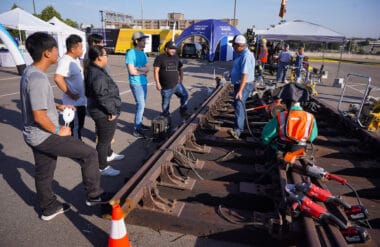
Experience and exploration: Students delved deep into immersive activities, from solving manufacturing-related puzzles in the Creators Wanted mobile experience to virtually navigating a locomotive through Union Pacific’s simulators. Equally captivating was the sight of the actual railroad track, which was complemented by insightful career anecdotes from Union Pacific professionals.
- Eighty-seven percent of students surveyed reported a significantly improved view of modern manufacturing careers after completing the immersive experience.
Live Q&A sessions: The stop also offered structured opportunities for students to learn about manufacturing organizations’ support for the next generation of talent, along with the importance of mentorship and personal development in shaping successful careers.
- The first session, featuring two Union Pacific senior managers—Amy Bang, Sr. manager of diversity and inclusion, and Ken Kuwamura, Jr., manager of talent acquisition—and Saint Paul College instructors, zeroed in on the crucial roles of mentorship, diversity and passion in career selection.
- The second session, with Jake Yernberg, automotive instructor, Saint Paul College; Caitlin Bundy, manager of corporate sustainability, Union Pacific; and Preeti Subramanian, senior product manager, Trane Technologies, accentuated the pivotal role of manufacturing in tackling global challenges. Panelists pointed out the advantages of the manufacturing sector, citing competitive pay and the sector’s potential in addressing global issues, such as sustainability and climate change.
Interactive Learning: Everfi®, Ecolab and Schwan’s joined Union Pacific in bringing in representatives to give students career advice—and offer activities to spark their curiosity.
- Everfi® showcased a new digital education program, “Future Creators,” co-developed with the MI and Union Pacific, to give middle and high school students a peek into STEM careers.
- Saint Paul College also took students on a tour of its robust Trades and Technical Education program.
Beyond the Tour: The Twin Cities event is a part of Union Pacific’s overarching “Careers on Track” initiative, which aims to inspire more women and youth to pursue modern industrial careers, and the Creators Wanted campaign’s sustained drive to enhance perceptions of manufacturing careers in the United States and empower more people to create the future.
The last word: “I want all of you out here, the students, to have an opportunity to go out there and win and compete and further your careers and do well in life,” said Rocker, echoing a theme the Creators Wanted Tour has promoted since its inception: manufacturers and manufacturing care about students and their future.
Next up: The pioneering Creators Wanted Tour concludes next month, Oct. 17–21, at the Circleville Pumpkin Show in Circleville, Ohio.
How Manufacturers Can Tap into a Large, Talented Workforce
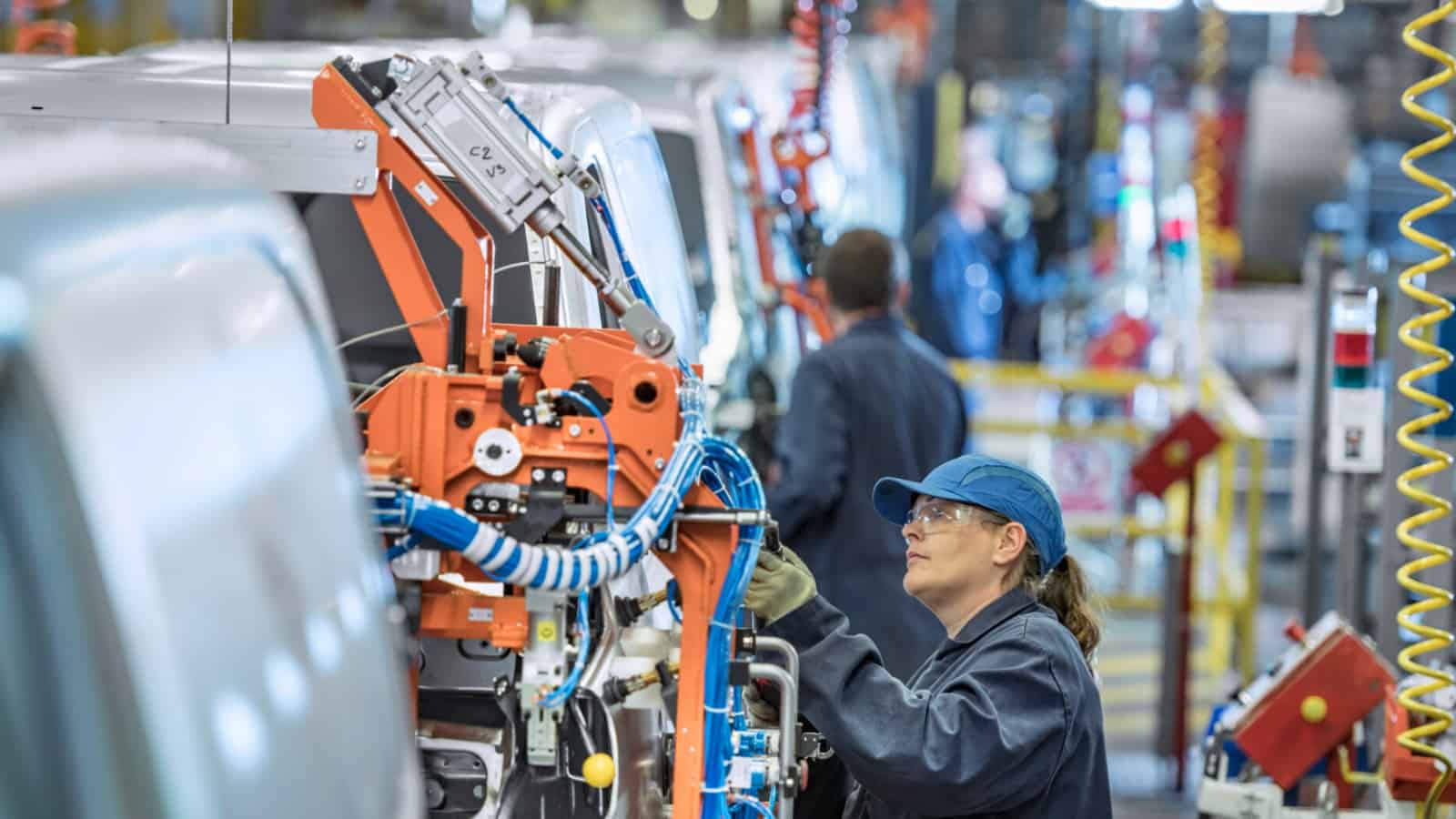
Discipline, reliability, a team-player mindset, leadership—manufacturers are looking for all these qualities in the talent they recruit. What if companies could tap into a population not only equipped with these skills but experienced in using them in high-stakes situations?
Well, the Manufacturing Institute—the workforce development and education affiliate of the NAM—has good news, if you haven’t heard it already: this population exists, and it’s military talent. Transitioning service members, veterans, National Guard members, reservists and military spouses have a wealth of skills and experience that translate easily into a manufacturing context.
So how can manufacturers reach these workers and make the best use of them? The MI recently convened both military and manufacturing leaders in Fayetteville, North Carolina, for its third Workforce Solution Series event, where they answered this question and offered a range of useful advice. Here are some of the highlights.
Generally speaking: Major General Eugene J. LeBoeuf, Deputy Commanding General, U.S. Army Reserve Command, highlighted the talents and skillsets that Army reservists can offer the manufacturing industry, including agility, a can-do attitude and a thorough grounding in engineering, logistics and mechatronics.
- With nearly 190,000 soldiers, the Army Reserve comprises much of the readiness force of the U.S. Army. Many of these reservists are underemployed or unemployed, which means they represent an opportunity for manufacturers.
- Manufacturers interested in hiring from this labor pool can partner with the Private Public Partnership Office, which connects companies with reservists at no cost.
Reaching military talent: Several panelists emphasized the importance of developing recruitment processes that encourage military talent to apply and interview for manufacturing jobs.
- “Make sure that the requirements you’re listing in your position descriptions are actually required. Do you really need someone to have a master’s degree to get the job done?” asked Rob Patton, vice president of Fayetteville Cumberland Economic Development Corporation.
- As a recently transitioned service member, James Goppert, HR business partner at WestRock, explained some of the challenges that military talent may face when entering the workforce. “Having to explain military skills and certifications to a civilian in an interview was strange. It would have been helpful to have someone on the other side who understood my experiences.”
Open to all possibilities: Jennifer Goodman, senior manager of talent initiatives at Coca-Cola Consolidated, drew on her experiences as a military spouse. “Military spouses are 92% women and have a 22% unemployment rate. That’s a huge labor pool that’s going underemployed or unemployed.”
- While relocation is often a concern for companies, Goodman points out that it does not have to be a disadvantage. “Think of manufacturers who have locations across the country. Maybe you can start a military spouse at one location and then move them to another. Or, if they’ve proven themselves after a few years, you could transition them to remote work.”
- “The benefits don’t stop with the one military spouse you hire,” she added. “We’re a very loyal community with great word of mouth and a larger referral network.”
The last word: “Don’t underestimate the value of an event like this Solution Series can have. You can take the information, energy and passion that you get from meeting with people who have the same goal of building a stronger economy and use it to power you forward,” said Nathan Huret, economic development director for Catawba County.
Learn more: To get started—or continue—with hiring military talent, check out the extensive resources of the MI’s Heroes MAKE America initiative, which prepares prospective military workers for new and rewarding careers in manufacturing.
STEP Ahead Awards Honor Women in Manufacturing
Get the Latest News
Get involved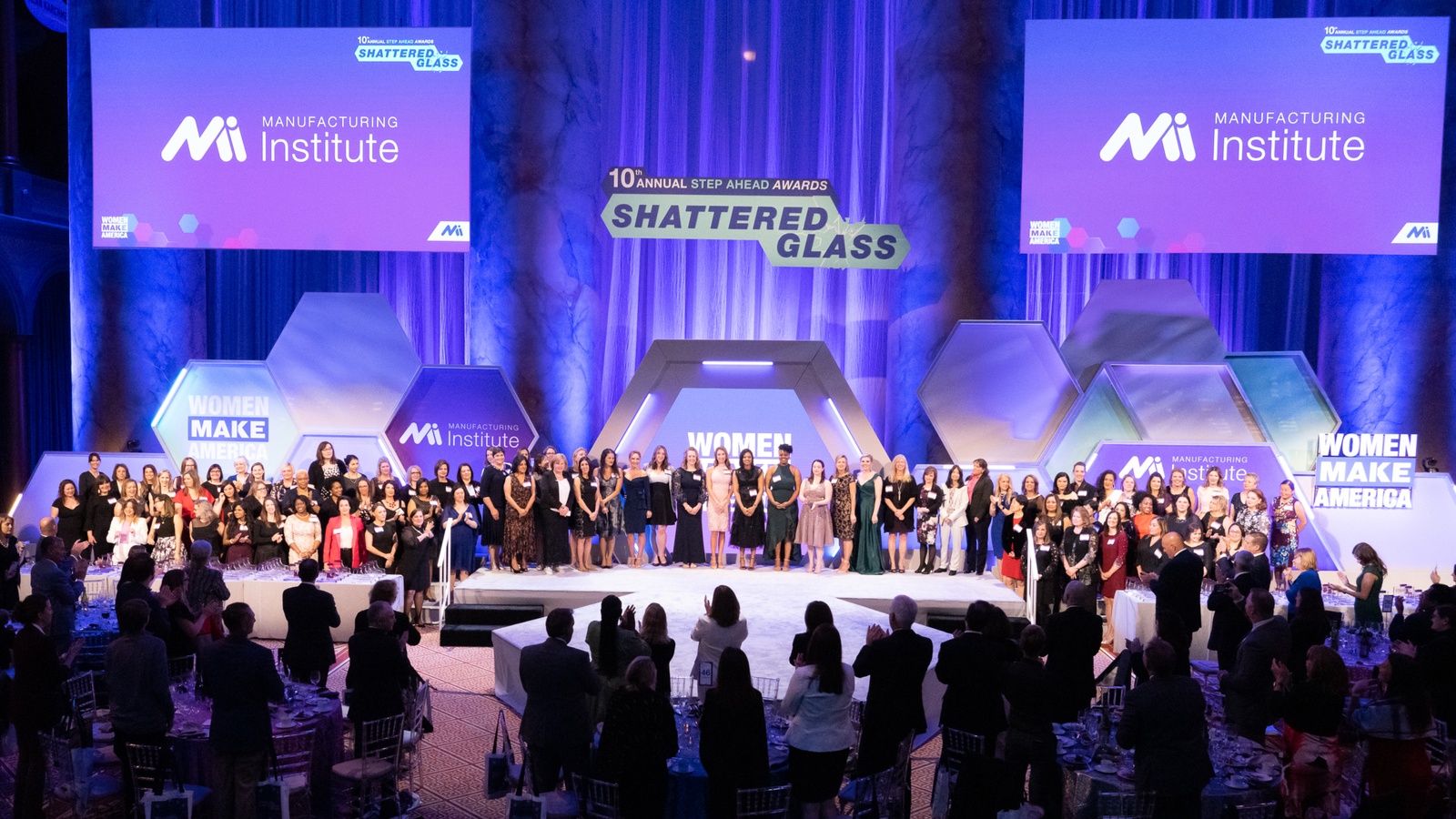
The Manufacturing Institute’s 10th annual STEP Ahead Awards took place in Washington, D.C., last week, honoring some of the most impressive and inspiring women in the manufacturing industry today. The Awards are part of the STEP Ahead program, which is designed to help advance women’s achievements in the fields of science, technology, engineering and production.
- The event highlighted the 2022 STEP Ahead Honorees (100 women who are leaders in manufacturing) and the 2022 STEP Ahead Emerging Leaders (30 women under 30 years old who have already had a significant impact on the industry).
The awards ceremony took place on Thursday night, with hundreds of guests in attendance at the National Building Museum and hundreds more viewing the ceremony online. The program featured:
- 2022 STEP Chair and former 3M Senior Vice President Denise Rutherford;
- 2022 STEP Vice Chair and Cornerstone Building Brands President and CEO Rose Lee;
- MI President Carolyn Lee;
- MI Vice President of Strategic Engagement and Inclusion AJ Jorgenson; and
- NAM President and CEO and MI Board Chair Jay Timmons.
Sponsors included an all-star roster of manufacturers, including Arconic Foundation, BASF Corporation, Cornerstone Building Brands, PTC, Trane Technologies, ABB, Molson Coors, Novelis, Rockwell Automation, SABIC, Sherwin-Williams and Toyota.
What they said: Carolyn Lee lauded the Honorees and spoke about the importance of closing the skills gap by bringing more women into the manufacturing industry.
- “My hope is that 10 years down the line, when we meet here for the 20th anniversary of these awards, the young women we will honor won’t have even heard of the glass ceiling, because it’ll be ancient history,” said Lee.
- “And that will be thanks to the support system, the mentorship and the sterling examples set by the women in this room and the support from our allies.”
Rutherford spoke about leaders’ opportunities to work together to make important progress.
- “Throughout my career, I’ve learned that being a great leader, as an individual or as a company, means that we don’t go it alone,” said Rutherford. “True change only happens when we work together as trusted allies, advocates and sponsors.”
Rose Lee laid out the qualities that all the Honorees showed and highlighted their shared successes.
- “The STEP Ahead Awards recognize women in science, technology, engineering and production who exemplify leadership within their companies and within their communities,” said Lee. “Tonight is their night to celebrate their accomplishments.”
Timmons praised the STEP Honorees and called on allies to continue supporting women in the manufacturing industry.
- “Your achievements, your success and your dedication are showing women what’s possible in manufacturing,” he said. “If you can see it, you know you can be it.”
35×30: Carolyn Lee and Jorgenson spoke about the 35×30 initiative—a program designed to close the skills and talent gap in manufacturing by adding half a million women workers to the industry, increasing women’s representation in manufacturing from 29% today to 35% by 2030.
- The campaign will train more than 1,000 women mentors, build new tools and resources and work with manufacturing leaders to deploy proven strategies to attract and retain female talent.
- It will also support young women throughout their education by offering best-in-class leadership development programming and creating a STEP alumnae-funded scholarship.
- “Tonight, we are done with waiting for other leaders to ‘change things,’ to make society better, more equitable,” said Jorgenson. “We are the leaders. So, tonight, we ask you to join us, to lead.”
New commitments: To help this new initiative along its way, Arconic Foundation President Ryan Kish and Ketchie CEO Courtney Silver stood up during the ceremony to pledge new financial commitments to the program.
The last word: The gala featured a stellar musical performance by award-winning singer–songwriter Rachel Platten, which left not a dry eye in the house. Inspired by the women of STEP, she surprised the audience by singing a new song she’d written for her daughters. It captures what the women leaders of today want to tell the girls who will someday be their heirs:
Girls, you were born to run. To reach the stars and chase the sun.
Girls, you’re wild and free. The wind is at your back, the world is at your feet.
